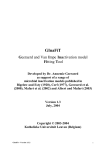Download A Quadratic Propagator for the Inter-Distance
Transcript
A Quadratic Propagator for the Inter-Distance Constraint
Claude-Guy Quimper
QUIMPER @ ALUMNI . UWATERLOO . CA
University of Waterloo
School of Computer Science
Alejandro López-Ortiz
ALOPEZ - O @ UWATERLOO . CA
University of Waterloo
School of Computer Science
Gilles Pesant
PESANT @ CRT. UMONTREAL . CA
École Polytechnique de Montréal
Department of Computer Engineering
Editor: Pascal Van Hentenryck
Abstract
We present a new propagator achieving bounds consistency for the I NTER -D ISTANCE constraint. This constraint ensures that, among a set of variables X1 , . . . , Xn , the difference between two variables is at least
p. This restriction models, in particular, scheduling problems in which tasks require p contiguous units of a
disjunctive resource to be completed. Until now, the best known propagator for bounds consistency had time
complexity O(n3 ). In this work we propose a quadratic propagator for the same level of consistency. We
then show that the theoretical gain gives savings of an order of magnitude in our benchmark of scheduling
problems. Our propagator is also the first one to filter the variable p.
1. Introduction
The cumulative scheduling problem with one resource of capacity C consists of a set of tasks T1 , . . . , Tn to
which we associate four integer variables: a release time ri , a deadline di , a processing time pi and a capacity
requirement ci . Each task Ti must start at time ti such that ri ≤ ti ≤ di − pi . Let Ω(t) be the set of tasks
in
Pprocess at time t, i.e. the tasks Ti such that ti ≤ t ≤ ti + pi . We have the resource capacity constraint
Ti ∈Ω(t) ci ≤ C. This problem is NP-Hard even in the case where C = 1 which we call, in this particular
case, the disjunctive scheduling problem.
Edge finders (Carlier and Pinson (1994); Mercier and Van Hentenryck (2005)) have largely been used to
solve scheduling problems. This technique reduces the intervals [ri , di ] by detecting time zones that must
be allocated to a subset of the tasks making these zones unavailable for other tasks. The goal is to increase
release times and reduce deadlines without eliminating any feasible solution. The problem is said to be
bounds consistent when intervals [ri , di ] have been fully shrunk, i.e. when there exists at least one feasible
schedule in which task Ti starts on time ri and at least one feasible schedule in which task Ti finishes on
time di . It is NP-Hard to make a scheduling problem bounds consistent, even in the disjunctive case. For this
reason, edge finders try to reduce, in polynomial time, the size of the intervals without necessarily achieving
bounds consistency. A backtracking search assigns starting times to tasks and uses the edge finder to reduce
the size of the search tree.
1
We study the disjunctive scheduling problem when all tasks have the same processing time pi = p. This
problem can be solved in polynomial time (Garey et al. (1981)) but traditional algorithms only return one
solution that generally does not satisfy the side constraints. These side constraints can even make the problem
NP-Hard. See, for instance, the runway scheduling problem (Artiouchine et al. (2004)). The flexibility that
constraint programming offers to encode such problems is an asset. A single I NTER -D ISTANCE constraint
can encode the disjunctive scheduling problem. This constraint ensures that starting times are pairwise distant
by at least p units of time. The global constraint offers a stronger pruning than the O(n2 ) associated binary
constraints |Xi − Xj | ≥ p.
Artiouchine and Baptiste (2005) recently proposed an O(n3 ) propagator that enforces bounds consistency
on the I NTER -D ISTANCE constraint. By achieving bounds consistency, their propagator prunes the search
space better than edge finding algorithms resulting in smaller choice points in the backtracking search and a
better time performance. We propose in this work a quadratic propagator that is faster both in theory and in
practice, even for small instances. We generalize the I NTER -D ISTANCE constraint by letting the distance P
be a constrained variable whose domain can be pruned. This proves to be useful when one wants to maximize
the distance between each pair of variables. The generalization of the I NTER -D ISTANCE constraint as well
as the experiments with this new constraint extend the work previously presented in Quimper et al. (2006).
Throughout the paper, we will consider the set [a, b] as the interval of integer values between a and b
inclusively. If a > b, then the interval [a, b] is empty. We nevertheless say that the lower bound of the interval
is min([a, b]) = a and the upper bound is max([a, b]) = b as for non-empty intervals.
We present in Section 2 some notions about how bounds consistency can be enforced on the I NTER -D ISTANCE
constraint. We then explain in Section 3 how the computation can be simplified. Based on this simplification,
we present in Section 4 our algorithm and a data structure that ensures the quadratic behaviour of our propagator. We show in Section 5 how bounds consistency can be enforced on the distance variable P . Finally, we
present in Section 6 some experiments proving the efficiency of our propagator.
2. The I NTER -D ISTANCE Constraint
Régin (1997) first introduced the I NTER -D ISTANCE constraint under the name global minimum distance
constraint. The expression I NTER -D ISTANCE([X1 , . . . , Xn ], P ) holds if and only if |Xi − Xj | ≥ P for
all i 6= j. When P = 1, the I NTER -D ISTANCE specializes into an A LL -D IFFERENT constraint (Régin
(1994); Mehlhorn and Thiel (2000); López-Ortiz et al. (2003)). Régin (1994) showed that a single global
equivalent binary constraints. This
constraint, in many cases, causes more domain reduction than the n(n−1)
2
observation also applies to the I NTER -D ISTANCE constraint which is the general case. Artiouchine and
Baptiste provided the first propagator for the bounds consistency of the I NTER -D ISTANCE constraint. The
running time complexity of their propagator is cubic. Throughout the paper, we will assume that P is fixed
to a value p and therefore can be assigned to this value. In Section 5, we generalize to the case where P is
not fixed and show how to enforce bounds consistency on all constrained variables.
We use the following problem as a running example.
Example 1 Consider a problem with n = 3 tasks with starting times T1 , T2 , and T3 and processing time
p = 6 subject to the following release times and deadlines.
r1 = 2
r2 = 10
r3 = 4
d1 = 12
d2 = 20
d3 = 21
Figure 1 shows the release times and deadlines as well as a feasible schedule.
Let the domain of Ti be the interval [ri , di − p] i.e., T1 ∈ [2, 6], T2 ∈ [10, 14], and T3 ∈ [4, 15]. After
propagation of the constraint I NTER -D ISTANCE([T1 , T2 , T3 ], p), the variables get assigned to the following
values.
T1 = 2
T2 = 14
2
T3 = 8
Task 1
Task 2
Task 3
0
5
10
15
20
25
Figure 1: Release times and deadlines for the three tasks described in Example 1. The black rectangles
represent a feasible schedule.
Here, task T1 must finish before or at time 8 in order to allow tasks T2 and T3 to meet their deadlines.
Task T2 cannot start before time 14 since the two other tasks are not completed before this time. Finally, task
T3 must be executed between tasks T1 and T2 forcing its release time to be increased and its deadline to be
reduced.
Garey et al. (1981) designed an algorithm that finds a solution satisfying the I NTER -D ISTANCE constraint
in O(n log n) steps. Their algorithm proceeds in two phases. In the first phase, the algorithm computes a set
of intervals F in which no tasks are allowed to start. We call this set the forbidden regions and denote it by
F . Their number is bounded above by n, the number of tasks. Once these forbidden regions are computed,
the second phase uses a greedy strategy to schedule the tasks.
Artiouchine and Baptiste (2005) and Garey et al. (1981) use two basic functions as main pillars of their
algorithm. We define the completion time of a schedule as the time of completion of the very last task and
the starting time of a schedule as the starting time of the very first task. Let ect(F, r, q) be the earliest
completion time of a schedule of q tasks with release time r and unbounded deadline such that no task starts
in a forbidden region contained in the set of forbidden regions F . Symmetrically, let lst(F, d, q) be the latest
starting time of a schedule of q tasks with deadline d and unbounded release time such that no task starts in a
forbidden region in F . Computing ect(F, r, q) and lst(F, d, q) can be done in O(q) steps using the following
recurrences.
=
r
if q = 0
min{t 6∈ F | t ≥ ect(F, r, q − 1)} + p if q > 0
(1)
lst(F, d, q) =
d
if q = 0
max{t 6∈ F | t ≤ lst(F, d, q − 1) − p} if q > 0
(2)
ect(F, r, q)
The function lst helps to explain the algorithm of Garey et al. (see Algorithm 1) that computes the
forbidden regions F . Their algorithm starts with an empty set of regions F = ∅ and processes each release
time r in decreasing order. Consider a deadline d and let ∆(r, d) be the tasks whose release times and
deadlines are both contained in the interval [r, d]. The value lst(F, d, |∆(r, d)|) − r represents the amount of
slack in the interval [r, d], i.e. an upper bound on the processing time that can be used in the interval [r, d] for
tasks that are not in ∆(r, d). If lst(F, d, |∆(r, d)|) − r is smaller than p then there is not enough room to fit a
whole task not in ∆(r, d). The algorithm therefore appends to F the forbidden region [lst(F, d, |∆(r, d)| +
1) + 1, r − 1]. Indeed, any task starting in this region consumes too much time in the interval [r, d] to
allow the completion of the tasks in ∆(r, d). If lst(F, d, |∆(r, d)|) − r < 0, there are too many tasks that
require to be executed in the interval [r, d], the problem is unsolvable. Upon termination, the set of forbidden
regions contains up to n distinct regions. These regions are sufficient to find a solution to the problem but
are insufficient to enforce bounds consistency on the I NTER -D ISTANCE constraint. Artiouchine and Baptiste
explain how to compute a larger set of regions that are sufficient to filter the I NTER -D ISTANCE constraint.
Using the functions ect and lst, Artiouchine and Baptiste describe two types of adjustment intervals
necessary and sufficient to maintain bounds consistency on the I NTER -D ISTANCE constraint. An internal
3
F ←∅
R ← the set of release times
D ← the set of deadlines
for r ∈ R in decreasing order do
d ← argmin lst(F, d, |∆(r, d)|) − r
d∈D
s ← lst(F, d, |∆(r, d)|) − r
if s < 0 then
return The problem is unsolvable
else if s < p then
F ← F ∪ [lst(F, d, |∆(r, d)| + 1) + 1, r − 1]
return F
Algorithm 1: Algorithm that computes the forbidden regions. Garey et al. (1981) use special data structures
to obtain a complexity of O(n log n).
adjustment interval is an interval in which no task is allowed to start. The set of internal adjustment intervals
is a superset of the forbidden regions F .
Definition 1 (Internal Adjustment Interval) Given two time points r and d and an integer 0 ≤ q <
|∆(r, d)|, the internal adjustment interval Ir,d,q is defined as follows.
Ir,d,q
=
[lst(F, d, q + 1) + 1, ect(F, r, |∆(r, d)| − q) − 1]
(3)
Theorem 2 presents in which context we will use internal adjustment intervals.
Theorem 2 (Artiouchine and Baptiste (2005)) Given two time points r, d, and an integer 0 ≤ q < |∆(r, d)|,
no task can start in the interval Ir,d,q .
Internal adjustment intervals appear in problems where a group of variables must be assigned to values in
an interval that is small enough to force a certain structure to be maintained. The internal adjustment intervals
ensure that a single variable does not occupy the “space” of two variables.
The external adjustment intervals are intervals in which a subset of the tasks are not allowed to start.
Definition 3 (External Adjustment Intervals) Given two time points r and d and an integer 0 ≤ q <
|∆(r, d)|, the internal adjustment interval Er,d,q is defined as follows.
Er,d,q
= [lst(F, d, q + 2) + 1, ect(F, r, |∆(r, d)| − q) − 1]
(4)
Theorem 4 shows the main property of external adjustment intervals.
Theorem 4 (Artiouchine and Baptiste (2005)) Given two time points r, d and an integer 0 ≤ q < |∆(r, d)|,
a task i 6∈ ∆(r, d) cannot start in the interval Er,d,q .
External adjustment intervals appear in problems where a group of variables compete for an interval of
values. The variables whose domain is not restricted to this small interval and hence do not belong to this
group of competing variables must be assigned to values outside of the interval.
Table 1 shows the internal and external adjustment intervals from Example 1.
Artiouchine and Baptiste formally proved that the internal and external adjustment intervals are necessary
and sufficient to enforce bounds consistency on the I NTER -D ISTANCE constraint.
4
ri \dj
2
4
10
ri \dj
2
4
10
Internal Adjustment Intervals
20
21
{[9, 7], [15, 13]} {[3, 7], [9, 13], [16, 19]}
{[15, 9]}
{[9, 9], [16, 15]}
{[15, 15]}
{[16, 15]}
External Adjustment Intervals
12
20
21
{[−3, 7]} {[3, 7], [9, 13]} {[−3, 7], [3, 13], [9, 19]}
∅
{[9, 9]}
{[3, 9], [9, 15]}
∅
{[9, 15]}
{[9, 15]}
12
{[7, 7]}
∅
∅
Table 1: Internal and external adjustment intervals generated by a pair of time points (ri , dj ) from Example 1.
Intervals are written in decreasing order with respect to parameter q. The forbidden regions are
F = {[−3, 1], [3, 3], [9, 9]}.
3. Towards a Quadratic Time Propagator
Internal and external adjustment intervals in the worst case may be computed with up to n possible release
times r, n possible deadlines d and produce O(n) adjustment intervals each. Therefore, O(n3 ) adjustment
intervals could be checked in the worst case, hence the cubic time complexity of the Artiouchine-Baptiste
propagator.
In fact, the union of all internal and external adjustment intervals consists of a maximum of O(n2 ) disjoint
intervals. It is therefore possible to ignore intervals that are subsets of already discovered intervals in order
to achieve a quadratic complexity. To avoid computing redundant adjustment intervals, we introduce the
notion of dominance between two pairs of time points. When a pair of time points dominates another pair,
the adjustment regions of the dominant pair contain some adjustment regions of the other pair.
Definition 5 (Dominance) A pair of time points (r, d) dominates a pair of time points (r′ , d′ ) if we have
min(Ir,d,q ) ≤ min(Ir′ ,d′ ,q ) and max(Ir,d,q ) ≥ max(Ir′ ,d′ ,q ) for all 0 ≤ q < min(|∆(r, d)|, |∆(r′ , d′ )|). We
write (r, d) ≻ (r′ , d′ ).
Notice that we usually have |∆(r, d)| =
6 |∆(r′ , d′ )|. The definition of dominance only applies for q
′ ′
below min(|∆(r, d)|, |∆(r , d )|). Also, for a fixed deadline d, the dominance operator (≺) is transitive,
i.e. if (ri , d) ≺ (rj , d) and (rj , d) ≺ (rk , d) hold, then (ri , d) ≺ (rk , d) holds. In Example 1 we have
(2, 21) ≻ (4, 21).
The following lemmas describe a property of the ect and lst functions that will allow us to efficiently
decide if a pair of time points dominates another one.
Lemma 6 If ect(F, r, q) ≤ ect(F, r′ , q ′ ) then ect(F, r, q + k) ≤ ect(F, r′ , q ′ + k) for any k ≥ 0.
Proof The proof is by induction on k. The base case k = 0 is trivial. Suppose that the lemma holds for
k − 1. We have ect(F, r, q + k) = ect(F, r, q + k − 1) + p + s where s is a (potentially null) shift caused
by the (potentially empty) forbidden region Fi = [ect(F, r, q + k − 1), ect(F, r, q + k − 1) + s] ⊆ F .
Similarly we have ect(F, r′ , q ′ + k) = ect(F, r′ , q ′ + k − 1) + p + s′ where s′ is the shift caused by
the forbidden region Fj = [ect(F, r′ , q ′ + k − 1), ect(F, r′ , q ′ + k − 1) + s′ ] ⊆ F . If s is large enough
to obtain ect(F, r, q + k) ≥ ect(F, r′ , q ′ + k), then we have Fj ⊆ Fi . Since Fj is a subset of Fi ,
both functions ect(F, r, q + k) and ect(F, r′ , q ′ + k) are shifted to the same value. We therefore obtain
ect(F, r, q + k) = ect(F, r′ , q ′ + k) which completes the induction step.
Lemma 7 If lst(F, d, q) ≤ lst(F, d′ , q ′ ) then lst(F, d, q + k) ≤ lst(F, d′ , q ′ + k) for any k ≥ 0.
5
Proof Symmetric to the proof of Lemma 6.
We now describe three different situations in which a pair of time points dominates another one. The first
case is described in Lemma 8.
Lemma 8 Consider the pairs of time points (r, d) and (r, d′ ) such that d < d′ . If |∆(r, d)| = |∆(r, d′ )| then
(r, d) ≻ (r, d′ ).
Proof Let k = |∆(r, d)| = |∆(r, d′ )|. We have lst(F, d, 0) < lst(F, d′ , 0) and by Lemma 7, for any
0 ≤ q < k, we have lst(F, d, q + 1) ≤ lst(F, d′ , q + 1). This implies min(Ir,d,q ) ≤ min(Ir,d′ ,q ) and since
we have max(Ir,d,q ) = max(Ir,d′ ,q ) we have (r, d) ≻ (r, d′ ).
From Lemma 8 we conclude that (10, 20) ≻ (10, 21) in Example 1. Similarly, we have the following
Lemma.
Lemma 9 Consider the pairs of time points (r, d) and (r′ , d) such that r < r′ and |∆(r, d)| = |∆(r′ , d)|.
Then (r, d) ≺ (r′ , d).
Proof Let k = |∆(r, d)| = |∆(r′ , d)|. We have ect(F, r, 0) < ect(F, r′ , 0) and by Lemma 6, for any
0 ≤ q < k, ect(F, r, k − q) ≤ ect(F, r′ , k − q). This implies max(Ir,d,q ) ≤ max(Ir′ ,d,q ) and since we have
min(Ir,d,q ) = min(Ir′ ,d,q ) we have (r, d) ≺ (r′ , d).
In Example 1, Lemma 9 detects (4, 20) ≺ (10, 20). We show a last case where a pair of time points
dominates another one.
Lemma 10 Let (r, d) and (r′ , d) be two pairs of time points such that |∆(r, d)| = |∆(r′ , d)| + k and
ect(F, r, k) ≤ ect(F, r′ , 0). Then (r′ , d) ≻ (r, d).
Proof Clearly, for 0 ≤ q < |∆(r′ , d)|, the internal adjustment intervals Ir,d,q and Ir′ ,d,q share the same
lower bound. For the upper bounds, we have the following:
max(Ir,d,q ) = ect(F, r, |∆(r, d)| − q) − 1
= ect(F, r, |∆(r′ , d)| + k − q)) − 1
≤ ect(F, r′ , |∆(r′ , d)| − q) − 1
Using Lemma 6 and ect(F, r, k) ≤ ect(F, r′ , 0)
(5)
≤ max(Ir′ ,d,q )
Therefore we have (r′ , d) ≻ (r, d).
In Example 1, we have (10, 20) ≻ (2, 20) from Lemma 10.
Lemma 10 is crucial to obtain a quadratic algorithm. Consider a deadline d and a sequence of release
times r1 < r2 < . . . < rk such that (r1 , d) ≺ (r2 , d) ≺ . . . ≺ (rk , d). There can be up to O(n2 ) internal
adjustment intervals associated to these pairs of time points. Nevertheless, the union of all O(n2 ) intervals
can be given by the union of only O(n) intervals. Given two integers j and q such that 1 ≤ j ≤ k and
0 ≤ q < |∆(rj , d)|, we first notice that the following intervals all share a same lower bound. The union of
the intervals is therefore equal to the interval whose upper bound is the greatest.
j
[
Iri ,d,q
= [min(Irj ,d,q ), max max(Iri ,d,q )]
(6)
= [min(Irj ,d,q ), max(Irj ,d,q )]
= Irj ,d,q
(7)
(8)
1≤i≤j
i=1
6
We see that up to O(n) adjustment intervals can be contained in a single interval. Using this observation,
we compute the union of all adjustment intervals formed by the pairs (r1 , d), . . . , (rk , d) using the following
equation. To simplify the notation, we let |∆(rk+1 , d)| = 0 since rk+1 is undefined.
k |∆(r[
i ,d)|−1
[
i=1
Iri ,d,q =
q=0
k
[
|∆(ri ,d)|−1
[
Iri ,d,q
(9)
i=1 q=|∆(ri+1 ,d)|
Notice that the left hand side of Equation 9 has O(n2 ) intervals while the right hand side has only O(n)
Pk
intervals. Indeed, the number of intervals to unite is given by i=1 (|∆(ri , d)|−|∆(ri+1 , d)|). The telescopic
series simplifies to |∆(r1 , d)| − |∆(rk+1 , d)| = |∆(r1 , d)|. In Example 1 since we have (2, 20) ≺ (10, 20)
we obtain the following:
(I2,20,0 ∪ I2,20,1 ) ∪ (I10,20,0 )
= I2,20,1 ∪ I10,20,0
= [9, 7] ∪ [15, 15]
= [15, 15]
Theorem 11 There are O(n2 ) internal adjustment intervals that subsume any other internal adjustment
interval.
Proof Consider a deadline d and two release times ri ≤ rj . For every value 0 ≤ q < |∆(rj , d)|, we
have min(Iri ,d,q ) = min(Irj ,d,q ). We have max(Iri ,d,q ) ≥ max(Irj ,d,q ) if and only if (ri , d) ≻ (rj , d).
Consequently, we have Irj ,d,q ⊆ Iri ,d,q if and only if (ri , d) ≻ (rj , d).
Consider the list of release times r1 ≤ r2 ≤ . . . ≤ rn sorted in non-decreasing order. If for some k
we have (rk , d) ≻ (rk+1 , d), we can safely ignore the release time rk+1 since for every interval we have
Irk+1 ,d,q ⊆ Irk ,d,q for 0 ≤ q < |∆(rk+1 , d, q)|. After removing all dominated release times, we obtain a
list of release times rk1 ≺ rk2 ≺ . . . ≺ rkm . Equation 9 shows how the internal adjustment intervals Ir,d,q
for any r and q are subsumed by O(n) intervals. Since there are O(n) deadlines d, there are O(n2 ) internal
adjustment intervals that subsume any other internal adjustment interval.
4. A Quadratic Propagator
4.1 General Scheme
The idea behind the algorithm is the following. We process each deadline in increasing order. If two deadlines
di and dj are equal and their associated release times satisfy rj ≤ ri , we process both deadlines at the same
time but use di as a reference. For every deadline di , we compute the longest sequence of release times
rx1 < rx2 < . . . < rxk such that (rx1 , di ) ≺ (rx2 , di ) ≺ . . . ≺ (rxk , di ) as we did in Theorem 11. Using
this sequence and Equation 9, we compute the union of all internal adjustment intervals generated by the
pairs of time points whose deadline is di . To build the sequence, we iterate through all the release times in
non-decreasing order. Two cases can occur where we can safely skip a release time rj .
Case 1 (dj > di ): Suppose that the deadline dj associated to rj has not been processed yet, i.e. dj > di .
For such a release time rj , two cases can occur. We choose the smallest release time rk whose deadline
has already been processed and such that rk > rj . If such a rk exists, then |∆(rj , di )| = |∆(rk , di )| and
Lemma 9 insures that (rk , di ) ≻ (rj , di ). All adjustment intervals from (rj , di ) will be taken into account
when iterating through rk . If no such rk exists, then we have ∆(rj , di ) = ∅ and no adjustment intervals are
associated to the pair (rj , di ). In either case, the pair (rj , di ) can be ignored.
7
Case 2 (rj > ri ): A release time rj greater than ri can also be safely ignored. Let dl be the deadline
processed before di . Since |∆(rj , di )| = |∆(rj , dl )|, Lemma 8 insures that we have (rj , dl ) ≻ (rj , di ) and
adjustment intervals from (rj , di ) have already been taken into account when processing dl .
We prove that Algorithm 2 constructs for every deadline di a sequence rj1 < rj2 < . . . < rjk such that
(rj1 , di ) ≺ (rj2 , di ) ≺ . . . ≺ (rjk , di ). This sequence with Equation 9 compute the adjustment intervals.
1
2
3
4
5
6
7
8
9
10
Let D be the set of deadlines sorted in increasing order. If two deadlines are equal, exclude from D the
one whose associated release time is the smallest.
P ← ∅, A ← ∅, Ui ← ∅, ∀ 1 ≤ i ≤ n
for di ∈ D do
P ← P ∪ {j | dj = di }
l ← min(P )
for j ∈ P ∩ [l, i] do
a ← |∆(rj , di )|
b ← |∆(rl , di )|
if ect(F, rl , b − a) ≤ rj then
Ui ← Ui ∪ {(l, q) | a ≤ q < b}
l ← j;
Ui ← Ui ∪ {(l, q) | 0 ≤ q < |∆(rl , di )|}
for (j, q) ∈ Ui do A ← A ∪ Irj ,di ,q
for all deadlines di in non-decreasing order do
ri′ ← min{t 6∈ A | t ≥ ri }
if di ∈ D then
for (j, q) ∈ Ui do A ← A ∪ Erj ,di ,q
for i ∈ [1, n] do ri ← ri′
Algorithm 2: Enforcing bounds consistency for the I NTER -D ISTANCE constraint. We assume that the
forbidden regions F have already been computed and that release times are sorted such that ri ≤ ri+1 and
ri = ri+1 ⇒ di ≤ di+1 .
Lemma 12 Algorithm 2 encodes in the data structure Ui a sequence (rj1 , di ) ≺ (rj2 , di ) ≺ . . . ≺ (rjk , di )
generating all internal adjustment intervals associated to the deadline di .
Proof The for loop on line 2 processes each release time rj such that dj ≤ di and rj ≤ ri . Other release
times can be safely ignored as they correspond to the cases 1 and 2 stated above.
Line 3 tests whether ect(F, rl , b − a) ≤ rj . The first time Line 3 is executed, the test is positive since
l = j = min(P ) and a = b. We therefore include (rmin(P ) , di ) in the sequence. Subsequent tests are positive
only if the pair (rj , di ) dominates the last pair (rl , di ) tested positive as proved below.
ect(F, rl , b − a) ≤ rj =⇒ ect(F, rl , b − a) ≤ ect(F, rj , 0)
=⇒ ect(F, rl , b − q) ≤ ect(F, rj , a − q) ∀ 0 ≤ q < a
=⇒ (rl , di ) ≺ (rj , di )
by definition of ect (10)
by Lemma 6 (11)
by def. of dominance (12)
Similarly, one can prove that a negative test implies that (rl , di ) ≻ (rj , di ) and that the pair (rj , di ) should
not belong to the sequence. The sequence r1 ≺ r2 ≺ . . . ≺ rk is therefore not missing any release time.
Each time the relation (rl , di ) ≺ (rj , di ) is discovered, the algorithm appends to Ui the tuples (j, q) for
|∆(rj , di )| ≤ q < |∆(rl , di )|. Each tuple (j, q) ∈ Ui will be used later to create the internal internal adjustment intervals Irj ,di ,q . According to Equation 9, these intervals are sufficient.
8
Following Artiouchine and Baptiste (2005), the second for loop on line 8 processes the deadlines in nondecreasing order. The external adjustment intervals are therefore computed in an order that ensures that the
processed variable is not contained in any ∆(ri , dj ) considered so far.
Algorithm 2 only prunes the release times. Following Puget (1998), one can prune the deadlines by creating the symmetric problem where task Ti′ has release time ri′ = −di and deadline d′i = −ri . Algorithm 2 can
then prune the release times in the symmetric problem, which prunes the deadlines in the original problem.
The data structures P and Ui can be implemented using some linked lists. However, to obtain an algorithm
running in quadratic time, we need to craft a special data structure to store the adjustment intervals in A.
This data structure should allow the execution of lines 7, 9, and 10 in no more than O(n) time even if A
contains up to O(n2 ) intervals. The next section describes how the adjustment data structure A can meet
these requirements.
4.2 Keeping Track of Adjustment Intervals
To guarantee a quadratic running time, we must carefully design the data structure A that contains the adjustment intervals. We use a doubly-linked list containing all adjustment intervals sorted by lower bounds,
including empty intervals. Each interval Iri ,dj ,q has a pointer next(Iri ,dj ,q ) and previous(Iri ,dj ,q ) pointing
to the next and previous intervals in the list. The first interval has its previous pointer undefined as the last
interval has its next pointer undefined. Each interval has also a pointer nextQ(Iri ,dj ,q ) pointing to Irk ,dj ,q+1
where rk and ri might be equal. If the interval Irk ,dj ,q+1 does not exist, the pointer is undefined. The data
structure initially contains an empty interval with lower bound −∞ used as a sentinel.
We implement Line 7 of Algorithm 2 as follows. We insert the intervals in decreasing order of lower
bounds. Since we process variables by increasing deadlines, the lower bound of Irj ,di ,0 is larger or equal to
any lower bound inserted in A and is therefore inserted at the end of the linked list.
Suppose we have inserted the interval I1 = Irj ,di ,q and we now want to insert the interval I2 = Irk ,di ,q+1 .
Algorithm 3 computes the insertion point in the linked list. The algorithm follows the previous pointers
starting from I1 until it either finds the insertion point or finds an interval Ira ,db ,q whose nextQ pointer
is assigned. In the latter case, the algorithm follows the nextQ pointer to finally follow the next pointers
until the insertion point is reached. When following the nextQ(Ira ,db ,q ) pointer, the algorithm necessarily
goes to or beyond the insertion point since we have min(Ira ,db ,q ) < min(I1 ) and by Lemma 7 we have
min(nextQ(Ira ,db ,q )) ≤ min(nextQ(I1 )) and therefore min(Ira ,db ,q+1 ) ≤ min(I2 ).
We show that Algorithm 3 inserts a sequence of O(n) intervals in the linked list A in O(n) steps.
Lemma 13 Algorithm 3 inserts on line 7 a sequence of O(n) internal adjustment intervals in the linked list
A in O(n) time.
Proof There is a maximum of n intervals in A whose nextQ pointer is undefined, therefore the first while
loop runs in O(n). Let I4 be an interval explored by the second while loop. The interval I4 lies between
nextQ(I) and the insertion point. By Lemma 7, if an interval I3 was pointing to I4 with its nextQ pointer,
the interval I3 would lie between I and I1 . Since I3 6= I, we conclude that no intervals point to I4 with its
nextQ pointer. There is a maximum of n such intervals. The second while loop runs in O(n). We therefore
showed that Line 7 can be implemented in O(n) steps.
nextQ
Ira ,db ,q+1
...
insert. point Ira ,db ,q
...
I1
Figure 2: Nodes in the doubly linked list that Algorithm 3 visits to find the insertion point of an adjustment
interval.
9
I ← previous(Irj ,di ,q )
I2 ← Irj ,di ,q+1
while nextQ(I) is undefined ∧ min(I) > min(I2 ) do
I = previous(I)
if min(I) > min(I2 ) then
I ← nextQ(I)
while min(next(I)) < min(I2 ) do
I ← next(I)
Insert I2 after I
Algorithm 3: Compute the insertion point of Irj ,di ,q+1 provided that Irj ,di ,q has already been inserted.
Line 10 inserts in A a sequence of O(n) external adjustment intervals. Notice that at this point, A already
contains the internal adjustment intervals and that by definition, the lower bound of Eri ,dj ,q is equal to the
lower bound of Irk ,dj ,q+1 . Line 10 can be implemented by simply changing Irk ,dj ,q+1 in A by Eri ,dj ,q . If
Irk ,dj ,q+1 does not exist in A, it can be added using Algorithm 3.
Lemma 14 A sequence of O(n) external adjustment intervals can be inserted in O(n) time.
Proof For every pair (j, q) ∈ Ui , one can keep a pointer on its associated interval Irj ,di ,q in the data structure
A. Following the nextQ pointer to reach Irk ,di ,q+1 takes constant time. Setting the new upper bound of
Irk ,di ,q+1 also takes constant time. The nextQ pointer is undefined for the last interval to insert, Algorithm 3
can insert the interval Irk ,di ,q+1 in O(n) steps. The total running time complexity is therefore O(n).
Line 9 of Algorithm 2 can be implemented in O(α(n)) steps where α is the inverse of Ackermann’s
function. We create a union-find data structure S with elements from 1 to n. For each element i, we associate
a time ti initially set to ri and a pointer pi initially unassigned. When inserting adjustment intervals in A in
decreasing order of lower bounds, we simultaneously iterate in decreasing order the sets in S. If an interval
I is inserted such that ti ∈ I, we change ti to max(I) + 1. We then follow the next pointers from I to check
if other intervals intersect ti and increase ti for each intersecting interval. If ti becomes greater or equal to
ti+1 , we merge the set in S containing i with the set containing i + 1. The pointer pi is used to keep track
of the last interval I tested with ti in order not to check twice a same interval. When executing Line 9 of
Algorithm 2, we simply retrieve from S the set s containing i and return tj where j = max(s).
Lemma 15 Updating and requesting the variables ti is performed in O(n2 ) steps.
Proof There are up to O(n2 ) intervals in the data structure A and each of them can be visited at most once.
Indeed, the pointers pi make sure that the search is always resumed from the last visited position in the list
A. The union-find data structure ensures that if an interval I ∈ A increases more than one release time,
this operation is done in constant time since all release times are grouped in the same set in S and only the
representative ti of this set is updated. Merging the elements in S and requesting the representive elements
takes O(nα(n)). The total complexity is therefore O(n2 ).
4.3 Running Time Analysis
The function lst(F, di , q) can be implemented with a table L where lst(F, ri , q) = L[i][q]. Such a table
requires O(n2 ) steps to initialize and supports function evaluation in constant time. We use a similar table
to evaluate ect(F, r, q). The function |∆(r1 , di )| can trivially be computed in O(n) steps. Since the release
times are sorted in non-decreasing order, one can compute |∆(rj , di )| using the following recursion.
10
|∆(rj , di )| =
|∆(rj−1 , di )|
|∆(rj−1 , di )| − 1
if dj−1 > di
otherwise
(13)
The function |∆(ri , dj )| can be implemented with a table D such that D[i][j] = |∆(ri , dj )|. Initializing
the table using the recursion above requires O(n2 ) steps. Each function call then takes constant time.
Theorem 16 The running time complexity of Algorithm 2 is O(n2 ).
Proof We assume that the forbidden regions F have already been computed in O(n log n) time as explained
by Garey et al. (1981). The data structures P and Ui are implemented using linked lists and the functions
lst, ect, and |∆(ri , dj )| are implemented using tables. The data structure A is implemented with the data
structure described in Section 4.2. Release times and deadlines are sorted in O(n log n) time. Initializing the
algorithm therefore requires O(n2 ) time.
For a fixed i, every pair (l, q) added to Ui on line 4 and line 6 have a distinct component q ranging from
0 to n exclusively. There are therefore at most O(n) elements in Ui that were appended in O(1) time. The
complexity to build the list Ui is therefore O(n). Line 7 takes O(n) time to execute as stated by Lemma 13.
The total running time for the for loop on line 1 is therefore O(n2 ).
By Lemma 15, the cummulative running time complexity of the line 9 is O(n2 ). Line 10 takes O(n) time
to execute as stated in Lemma 14. The for loop on line 8 therefore runs in O(n2 ).
Since the initialization and the for loops on lines 1 and 8 all run in O(n2 ) time, the total running time
complexity of Algorithm 2 is also O(n2 ).
5. Achieving Bounds Consistency on the Distance Variable
We now consider the general form of the I NTER -D ISTANCE constraint i.e., when the distance variable P is
not fixed. The constraint I NTER -D ISTANCE(X1 , . . . , Xn , P ) is satisfied if and only if
i 6= j
=⇒ |Xi − Xj | ≥ P
(14)
Clearly, if there is an assignment hX1 , ..., Xn i that satisfies the case when P = p, then this assignment
is also a support for P = p − 1. Therefore, any value that has a support in the domain of Xi for P = p has
a support in the same domain for P < p. To prune the Xi variables, one only needs to find the values in the
domains that have a support for P = min(D(P )). The algorithm presented in Section 4, when used with
p = min(D(P )), can therefore prune the Xi variables.
To prune the domain of P , we rely on the following observation. If the constraint is unsatisfiable with
P = p, then it is unsatisfiable for P > p. Therefore, to achieve bounds consistency on the variable P , one
only needs to prune the value max(D(P )).
The algorithm by Garey et al. allows testing, in O(n log n) steps, whether there exists a solution for P =
p. Using a one-sided binary search, we can find the largest value in D(P ) such that the I NTER -D ISTANCE
constraint is satisfiable. A one-sided binary search returning value p whose test requires O(n log n) time has
a running time complexity of O(n log n log p). We can enforce bounds consistency on the I NTER -D ISTANCE
constraint when the distance variable is not fixed in O(n2 + n log n log p) steps.
6. Experiments
We implemented our algorithm using the ILOG Solver C++ library, (ILOG (1998))1. The library already
provides a propagator for the I NTER -D ISTANCE constraint called IlcAllMinDistance and offers two levels
1. The code discussed in this section is available upon request from the first author.
11
Scalability Test
3
Artiouchine-Baptiste
Our propagator
2.5
Time (s)
2
1.5
1
0.5
0
0
10
20
30
n
40
50
60
Figure 3: Running time of the Artiouchine-Baptiste propagator (O(n3 )) and our propagator (O(n2 )) as a
function of the number of tasks. For this scalability test, we set all release times to ri = 0 and
deadlines to di = 6n.
of consistency, namely IlcBasic and IlcExtended. We also implemented the Artiouchine-Baptiste propagator
(Artiouchine and Baptiste (2005)). The scalability test presented in Section 6.1 was run on a Pentium III 900
MHz with 256 Mb of memory and ILOG Solver 4.2. The experiments on the runway scheduling problem
presented in Section 6.2 were run on a AMD64 Opteron 250 with a 2.4 GHz dual processor (only one
processor was used) and 3 GB of RAM. We used on this computer the library ILOG Solver 6.1. All reported
times are averaged over 10 runs.
6.1 Scalability Test
In order to test the scalability of our propagator, we first consider a scheduling problem with a single
I NTER -D ISTANCE constraint over n tasks whose release times are ri = 0 and deadlines are di = np for
all tasks. This problem has a trivial solution and is solved without backtracking. We clearly see on Figure 3 that our propagator has a quadratic behaviour while the Artiouchine-Baptiste propagator has a cubic
behaviour. This observation is supported by the study of the third and second derivative.
6.2 Runway Scheduling Problem
We then study a runway scheduling problem (Artiouchine et al. (2004)). In this problem, n airplanes have
certain time intervals in which they can land. Airplane number i has si time intervals [ri1 , d1i ], . . . , [risi , dsi i ].
Following Artiouchine and Baptiste (2005), we create for each airplane a variable ti with domain [ri1 , dsi i ]
representing the landing time and a variable ci with domain [1, si ] representing the landing time interval. We
have the constraints ci ≥ k ⇐⇒ ti ≥ rik and ci ≤ k ⇐⇒ ti ≤ dki . Finally, we have the constraint
I NTER -D ISTANCE([t1 , . . . , tn ], P ) that ensures a gap of P between each landing. For security reasons, we
want to maximize the time P between each landing.
In order to fairly compare both propagators, we enhanced the Artiouchine-Baptiste propagator with the
algorithm presented in Section 5 to prune the variable P . With ILOG Solver, we set the goal of performing a
binary search on P . We also set the objective of minimizing −P . We use the default heuristics and parameters
proposed by ILOG Solver.
12
We used the same benchmark as Artiouchine and Baptiste (2005) on random runway scheduling problems
where the sizes of intervals and the gap between intervals may vary. Figure 4 shows the number of problems
solved in the benchmark in a given period of time. Our propagator has consistently solved the problems at
greater speed than the Artiouchine-Baptiste propagator. The two levels of consistency provided in ILOG for
the IlcAllMinDistance constraint were not able to compete with the Artiouchine-Baptiste propagator nor with
ours.
Number of Random Problems Solved in a Given Period of Time
100
90
Number of Problems Solved
80
70
60
50
40
30
20
10
0
0.0001
Our propagator
Artiouchine-Baptiste
0.001
0.01
0.1
1
10
Time (s)
Figure 4: Number of random problems from the benchmark that were solved in a given period of time.
We then consider the runway scheduling problem where all intervals have the same length. Over both
series of problems available in the benchmark Artiouchine and Baptiste (2005), we obtain an improvement
over the Artiouchine-Baptiste propagator proportional to n. This observation is compatible with the running
time complexities of the algorithms. Figure 5 shows the number of problems solved in a given period of
time. Again, the two levels of consistency provided in ILOG for the IlcAllMinDistance constraint were not
competitive.
7. Conclusion
We presented a new propagator achieving bounds consistency for the I NTER -D ISTANCE constraint. The
running time complexity of O(n2 ) improves by a factor of n the previous best known propagator. This
theoretical improvement gives practical savings in scheduling problems.
It is still an open problem whether there exists an O(n log n) propagator for the I NTER -D ISTANCE constraint achieving bounds consistency. It would also be interesting to study how the constraint could be generalized for the cumulative scheduling problem.
13
Percentage of Solved Problems in the Mono-Pattern Benchmark in a Given Period of Time
60
Percentage of Solved Problems
50
40
30
20
10
Our propagator
Artiouchine-Baptiste
0
0.001
0.01
0.1
1
10
100
Time (s)
Figure 5: Number of problems with equal intervals from the benchmark that were solved in a given period
of time.
References
K. Artiouchine and P. Baptiste. Inter-distance constraint: An extension of the all-different constraint for
scheduling equal length jobs. In Proceedings of the 11th International Conference on Principles and
Practice of Constraint Programming, pages pp. 62–76, 2005.
K. Artiouchine, P. Baptiste, and C. Dürr. Runway scheduling with holding loop. In Proceedings of Second
International Workshop on Discrete Optimization Methods in Production and Logistics, pages pp. 96–101,
2004.
J. Carlier and E. Pinson. Adjustment of heads and tails for the job-shop problem. European Journal of
Operation Rsearch, 78:146–161, 1994.
M.R. Garey, D.S. Johnson, B.B. Simons, and R.E. Tarjan. Scheduling unit-time tasks with arbitrary release
times and deadlines. SIAM Journal on Computing, 10(2):256–269, 1981.
ILOG. ILOG Solver 4.2 user’s manual, 1998.
A. López-Ortiz, C.-G. Quimper, J. Tromp, , and P. van Beek. A fast and simple algorithm for bounds
consistency of the alldifferent constraint. In Proceedings of the Eighteenth International Joint Conference
on Artificial Intelligence, pages pp. 245–250, 2003.
K. Mehlhorn and S. Thiel. Faster algorithms for bound-consistency of the sortedness and alldifferent constraint. In Proceedings of the Sixth International Conference on Principles and Practice of Constraint
Programming, pages pp. 306–319, 2000.
L. Mercier and P. Van Hentenryck. Edge finding for cumulative scheduling. Submitted for publication, 2005.
14
J.-F. Puget. A fast algorithm for the bound consistency of alldiff constraints. In Proceedings of the Fifteenth
National Conference on Artificial Intelligence, pages pp. 359–366, 1998.
C.-G. Quimper, A. López-Ortiz, and G. Pesant. A quadratic propagator for the inter-distance constraint. In
Proceedings of the 21rst National Conference on Artificial Intelligence (AAAI 06), pages pp. 123–128,
2006.
J.-C. Régin. A filtering algorithm for constraints of difference in CSPs. Proceedings of AAAI-94, pages pp.
362–367, 1994.
J.-C. Régin. The global minimum distance constraint. Technical report, ILOG, 1997.
15
































